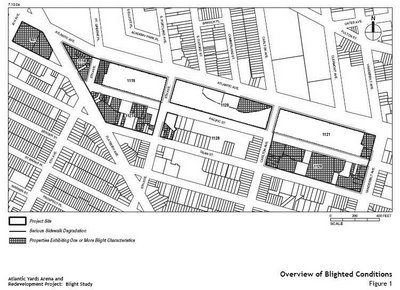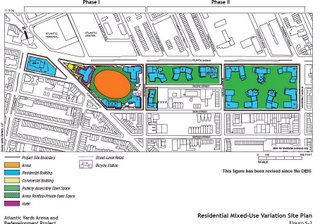 |
| Screenshot from Oct. 2006 NY Voices/WNET interview of Gargano by Rafael Pi Roman |
It was a strange time, and seems stranger still with ten years of perspective.
Atlantic Yards had been announced three years earlier, as Brooklyn was beginning to boom and developer Forest City Ratner was scouting around for new development deals. All seemed sunny.
But the ESDC was hardly an independent fact-finder, its board members with scant knowledge of the project. Chairman Charles Gargano, a political appointee, was either deluded or deflecting in his statements about eminent domain.
Now, with the benefit of hindsight, we also know that the ESDC did too little due diligence regarding the project. No, Atlantic Yards would not take ten years to build. No, the state had not prepared analyses showing what might happen if the real estate market and economy swiveled.
Nor had developer Forest City Ratner necessarily been prudent, having taken out loans to buy property under the expectation that it could soon start vertical development and deliver revenue, rather than pay carrying costs. Indeed, executives of parent Forest City Realty Trust now say one lesson is that they need to "control" land rather than purchase it.
A comment on my blog posted by "Marion" seems wise in retrospect, suggesting "a slow down in marketing all the other new buildings under construction (how goes 1 Hanson Place?) may have the greatest impact of all.... Neither Ratner nor the banks financing this project will proceed to build empty buildings. Time will tell."
Delays and doubts
 |
| Adjusted version of state map showing railyard not blighted and thus a larger share of project site not blighted |
The project was delayed after lawsuits and the economic downturn, and renegotiated in 2009, with an ostensible ten-year construction plan but a 25-year "outside date." That potential 2035 completion was adjusted, seemingly, by a 2014 agreement to build the affordable housing, at least, by 2025. That was linked to the state's approval of new majority investor Greenland USA.
But full 2025 project completion--and perhaps, the affordable housing--no long seems valid; in November, Forest City Realty Trust acknowledged it had stalled new development and was adjusting its economic forecasts to 2035, which likely indicates stabilization of cash flows a few years after completion. But we don't know for sure.
Still, perhaps the most important lesson after a decade is that the ostensible justification for state intervention, to remove "blight," was then and now bogus. First, the use of graffiti, cracks in the sidewalk, or underutilization to indicate blight was laughable, and ignored the context of a gentrifying neighborhood. The blight designation failed the "cappuccino test."
The Vanderbilt Yard, used to store and service Long Island Rail Road trains, was said by the state to be blighted. That was questionable--note the adapted map above--but, even if it we accept a below-grade railyard as de facto blighted, the project has proceeded in exactly the opposite way to "cure" that blight. Construction started on the arena block, and then moved not to the railyard, as was originally suggested, but to the southeast block of the project.
The ESDC decision: a recap
As I wrote, the ESDC board decision 12/8/06 was rubber-stamped. Though Gargano had said that “it’ll be up to the board members to vote yes or no” on Atlantic Yards, the press release had already been prepared The vote, by the four present board members out of seven total, was a formality.

Board members' brief questions and comments showed neither much understanding of the project location nor sympathies toward public concerns. And Gargano, gamely taking some tough questions from reporters afterward, gave no quarter.
The meeting began as Ann Hulka, a senior VP for real estate, uninflectedly read a boilerplate description of project changes officially announced the previous month.
“The entire project is expected to be completed by 2016,” she recited dutifully, adding that the project “avoids or minimizes adverse environmental impacts to the maximum extent practicable… and provides mitigation where practical and feasible.”
“A blight study was prepared which documents blighted conditions on the project site. ESDC intends to exercise the power of eminent domain to remove these blighted conditions," Hulka said. "Without condemnation, ESDC would be unable to assemble the site, remove the blighted conditions on the site, and develop the project.”
Of course, the major contributor to blight was the below-grade 8.5-acre railyard. Condemnation was not needed to "remove the blighted conditions on the site." That could have been accomplished by putting
Today the railyard awaits a deck, with a small segment, perhaps a quarter of the original parcel, now used for the arena.
At one point, board member Charles Dorkey, a bond lawyer, had identified Atlantic and Flatbush avenues on one poster. He pointed to the southern border of the project site. “Is that Pacific, at the bottom of the project?”
“This is Dean Street,” ESDC Director of Planning and Environmental Review Rachel Shatz responded patiently. “Pacific is the one in the middle.”
What about the timing?
Board member Joseph Holland asked about the timeline for the project, seemingly an issue already covered.
“The first phase, assuming no litigation," Hulka responded, "the first phase of the project-"
“Assuming no delays from litigation,” Gargano interjected, leaning forward a little tensely.
Hulka reiterated that the first phase—five towers, an arena, and a new and relocated railyard—would be completed by 2010, with the remainder of the project completed by 2016. The ESDC offered no worst-case scenario.
Afterward, when Gargano took press questions, I pointed out the skepticism of the planned ten-year buildout expressed by Kathryn Wylde of the Partnership for New York City, a project supporter who suggested the project would likely take 15-20 years.
“So how can you say this environmental review is sufficient?” I asked.
“Number one, I don’t know where Ms. Wylde’s facts come from” Gargano responded. “We hire consultants to advise us on these issues.... And they say the project can be built over a ten-year period... If the project is estimated to take ten years and we have some delays, as a result of lawsuits or whatever, it could take 11 years, or 12 years. So what... Those who are in the business of developing, those who understand construction, they’re the people we listen to, not the people who want to be out there talking numbers they have no knowledge of.”
The issue, of course, wasn't merely constructibility but rather whether the project was economically sustainable. It turns out that Wylde, like Laurie Olin, Chuck Ratner, and Marisa Lago after her--also participants in or supporters of the project--spoke wisely about delays.
“What about the track record with MetroTech?” I asked, pointing out that Forest City Ratner's Brooklyn project took nine years longer than planned.
“I have very little knowledge about MetroTech,” Gargano responded. “MetroTech started a long, long time ago.” Long enough for people to forget.
With some perspective
The video I mashed up in January 2010 combined footage from the board meeting (shot by the producers of Battle for Brooklyn), audio from two episodes of the Brian Lehrer Show in December 2006, footage (via NY State Senate) of a January 2010 hearing on eminent domain called by state Senator Bill Perkins, and footage (via BrooklynvsBush) of singer-songwriter John Pinamonti's prescient Atlantic Yards anthem/elegy, The Burrow, shot in May 2007.
As I wrote, probably the most astounding statement during the hearing came when ESDC General Counsel Anita Laremont asserted that ubiquitous environmental consultant "AKRF does not find blight; our board finds blight."
Now Laremont was speaking technically; legally, the board is charged with determining blight. But AKRF works for the project applicant either simultaneously (in the case of Columbia University's expansion) or consecutively (in the case of Forest City Ratner's Atlantic Yards project) with the ESDC.
AKRF gets contracts worth several million dollars to produce reports (paid for by the project applicant) on blight and environmental impact. Board members have no special training. They never disagree with AKRF.
As the video shows, Gargano, in a 12/7/06 appearance on WNYC's Brian Lehrer Show, stuttered, claiming improbably that the board did not plan to vote on eminent domain, a statement belied by footage of the ESDC board meeting and deemed by Lehrer, in his 12/11/06 follow-up show, an episode of "classic political evasiveness."
ESDC board member Dorkey is pictured showing his unfamiliarity with the project.
Interspersed with the statement by government officials and Lehrer are excerpts from roots musician John Pinamonti's anthem/elegy, "The Burrow," filmed in May 2007 at Freddy's Bar and Backroom, long demolished and and now part of the B3 (aka 38 Sixth Avenue) construction site.
"Come on down and see," Pinamonti invited his listeners. Gargano, Dorkey, and the rest of the board never bothered, so they couldn't figure out whether the neighborhood was "shot to hell," whether the site bordered a historic district, or even whether the decision could pass the "cappuccino test."
That's no coincidence. Because AKRF wasn't hired to do a neutral study of neighborhood conditions, as Laremont claimed at the hearing.
It was hired to "prepare a blight study in support of the proposed project," as shown in the contract scope for AKRF's work for ESDC, excerpted at right, part of a document I obtained via a Freedom of Information Law request.
But they still found blight.
"Post-truth"
The world of "post-truth" didn't begin with Candidate and PEOTUS Donald Trump. It's part of the real estate whirl, apparently.
After that 12/8/06 hearing, Nicholas Confessore of the New York Times pointed out to Gargano that he'd made factually incorrect and contradictory statements about eminent domain.
“I have no idea of what you’re talking about,” Gargano responded testily. “If you’re going to ask me a question, ask me a question."
Confessore continued, and Gargano responded, “Eminent domain has not occurred on this project. I never said it did.”
A bit later, Confessore offered the direct quote from Gargano’s May 17 interview in Metro, : “The facts are that we didn’t really have to use eminent domain because there were friendly condemnations done. The amount of condemnation that we had to do was very small.”
Faced with reality, Gargano denied it. “I don’t know what’s written there,” he said. “What I probably did say, I recall, is that if there is any condemnation that will be required, it would be very small.”
Today, perhaps fittingly, "Ambassador" Gargano is making bank as a promoter of an even more questionable enterprise: pitching EB-5 investor visas to Chinese millionaires desperate to buy their way into the United States.

Comments
Post a Comment